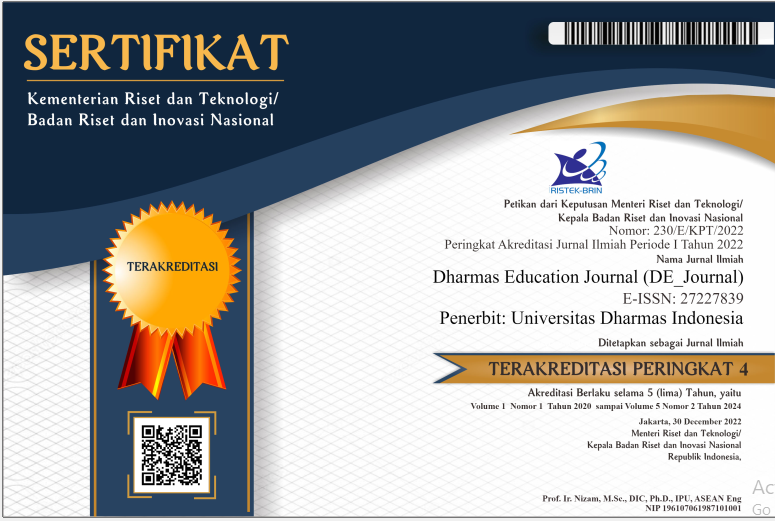EFEKTIVITAS FLIPPED CLASSROOM TERHADAP KEMAMPUAN BERPIKIR TINGKAT TINGGI MAHASISWA PGSD PADA MATA KULIAH MEDIA PEMBELAJARAN
DOI:
https://doi.org/10.56667/dejournal.v4i1.971Keywords:
Flipped Classroom, analyze, evaluate, create, Mann-WhitneyAbstract
The aim of the study was to determine the high-level thinking skills of PGSD students at Dharmas Indonesia University in learning media courses by applying the flipped classroom model. The desired results test the effectiveness of the flipped classroom model in learning media courses on students' analytical, evaluation and creative abilities. Type of R&D research with ADDIE development procedure. The results showed that the effectiveness of the flipped classroom model in the learning activities of learning media courses for PGSD students at Dharmas Indonesia University had an average of 1.84. on the ability to analyze, the average is 1.84 on the ability to evaluate and the average is 1.09 on the ability to create. Testing the effectiveness of the model was carried out using the Mann-Whitney non-parametric statistical analysis test obtaining a significance level of 0.002 for the ability to analyze, 0.007 for the ability to evaluate and 0.008 for the ability to create. These values are less than 0.05, which means that the flipped classroom model implemented is able to improve the ability to analyze, evaluate and create the ability of PGSD students at Dharmas Indonesia University
Downloads
References
Chen Hsieh, J. S., Huang, Y. M., & Wu, W. C. V. (2017). Technological acceptance of LINE in flipped EFL oral training. Computers in Human Behavior, 70, 178–190. https://doi.org/10.1016/J.CHB.2016.12.066
Crews, T., & Butterfield, J. B. (2014). Data for Flipped Classroom Design: Using Student Feedback to Identify the Best Components from Online and Face-to-Face Classes. Higher Education Studies, 4(3), 38–47. https://doi.org/10.5539/hes.v4n3p38
Enfield, J. (2013). Looking at the Impact of the Flipped Classroom Model of Instruction on Undergraduate Multimedia Students at CSUN. TechTrends, 57, 14–27.
Gariou-Papalexiou, A., Papadakis, S., Manousou, E. (Gelly), & Georgiadu, I. (2017). Implementing a flipped classroom: A case study of biology teaching in a greek high school. Turkish Online Journal of Distance Education, 18(3), 47–65. https://doi.org/10.17718/tojde.328932
Havwini, T., & Wu, Y.-T. (2019). the Implementation of Flipped Classroom in Efl Class: a Taiwan Case Study. Journal of Digital Education, Communication, and Arts (Deca), 2(02), 79–88. https://doi.org/10.30871/deca.v2i02.1536
Johnson, G. B. (2013). Student perceptions of the Flipped Classroom [University of British Columbia]. https://doi.org/10.14288/1.0073641
Lo, C. K., & Hew, K. F. (2017). A critical review of flipped classroom challenges in K-12 education: possible solutions and recommendations for future research. Research and Practice in Technology Enhanced Learning, 12(1). https://doi.org/10.1186/s41039-016-0044-2
Love, B., Hodge, A., Grandgenett, N., & Swift, A. W. (2014). Student learning and perceptions in a flipped linear algebra course. International Journal of Mathematical Education in Science and Technology, 45(3), 317–324. https://doi.org/10.1080/0020739X.2013.822582
Maolidah, I. S., Ruhimat, T., & Dewi, L. (2017). Efektivitas Penerapan Model Pembelajaran Flipped Classroom Pada peningkatan Kemampuan Berfikir Krit. Edutcehnologia, 3(2), 160–170.
Melissa Bond. (2020). Facilitating student engagement through the flipped learning approach in K-12: A systematic review. 151.
Mohan, D. (2018). Flipped Classroom, Flipped Teaching and Flipped Learning in the Foreign/Second Language Post–Secondary Classroom. Nouvelle Revue Synergies Canada, 11(11), 1–12. https://doi.org/10.21083/nrsc.v0i11.4016
Moleong, L. J. (2010). Metodologi Penelitian Kualitatif (Revisi). PT Remaja Rosdakarya.
Murillo-Zamorano, L. R., López Sánchez, J. Á., & Godoy-Caballero, A. L. (2019). How the flipped classroom affects knowledge, skills, and engagement in higher education: Effects on students’ satisfaction. Computers & Education, 141, 103608. https://doi.org/10.1016/J.COMPEDU.2019.103608
Pendidikan, M., Kebudayaan, D. A. N., & Indonesia, R. (2013). Menteri pendidikan dan kebudayaan republik indonesia (Vol. 2011).
Salatiga, M., Materi, P., Karim, M., & Saptono, S. (2020). Penerapan Flipped Learning Pada Pembelajaran Daring Efek Pandemi Covid-19 dalam Meningkatkan Motivasi Peserta Didik (Issue 2016).
Stephanie, S. (2015). Advances in Engineering Education The Evolution of a Flipped Classroom : Evidence-Based Recommendations. 1–37.
Sutama, Yulia Maftuhah Hidayati, M. N. (2022). Metode penelitian pendidikan. Muhammadiyah University Press.
Yuniarsih, Y., Hapsari, E. K., & Zakaria, M. (2020). Blended Learning Approach Using Flipped Classroom Model on Kaiwa Iii. Jurnal Kata, 1, 28. https://doi.org/10.22216/kata.v1i0.5064
Downloads
Published
How to Cite
Issue
Section
License
Copyright (c) 2023 Dharmas Education Journal (DE_Journal)

This work is licensed under a Creative Commons Attribution-NonCommercial-NoDerivatives 4.0 International License.
Makalah yang disampaikan diasumsikan tidak mengandung bahan propietary yang tidak dilindungi oleh hak paten














